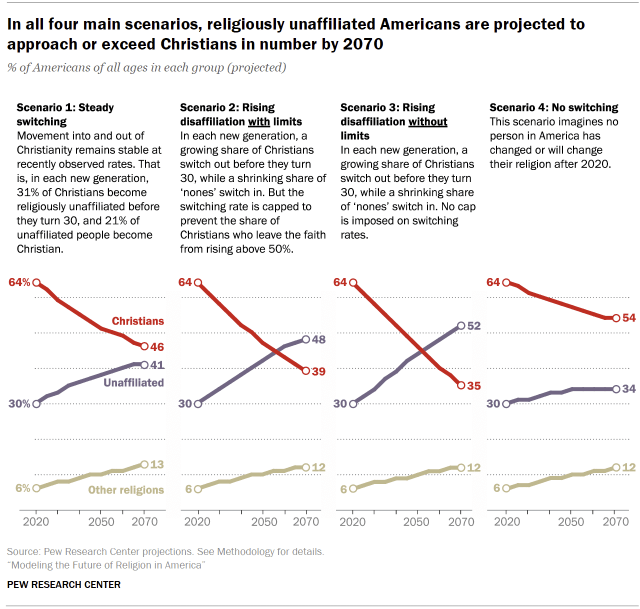35% to 54%: projected percentage of US self-identified Christians by 2070
In 50 years’ time, those not religiously affiliated could represent half of the population while people with non-Christians faiths double their presence.
Pew Research · CHICAGO · 15 SEPTEMBER 2022 · 16:05 CET

From a merely sociological perspective, the number of people identifying as Christians in the United States is destined to shrink.
According to a recent Pew Research projection, the number of self-identified Christians (who were 64% in 2020) could fall to half by 2070. Pastors and other Christian workers will not be surprised by the conclusion after witnessing the shrinking trend of the last decades. But is there a way to predict how this decline in Christian affiliation will look like?
A first scenario suggested in the “Modelling the Future of Religion in America” report says that 46% of the US populations will identify as Christians (including evangelicals, mainline Protestants, Roman Catholics and others smaller groups) in 2070, compared to 41% saying they are unaffiliated (agnostics, atheists, others). This scenario is contemplates that “movement into and out of Christianity remains stable at recently observed rates”. In other words, “in each new generation, 31% of Christians become religiously unaffiliated before they turn 30, and 21% of unaffiliated people become Christians”.
In a second model calculated by Pew (called “limited” disaffiliation), the reality changes drastically. The unaffiliated population would reach 48%, surpassing significantly the amount of Christians, which falls to 39%.
A third scenario predicting disaffiliation without mathematically imposed “limits” paints society in which over half of the population does not identify with a religion (52%) while Christianity would be the faith of 35% of US Americans.
Interestingly, the report also gives the model of what would happen if no Americans changed their religious affiliation in the next 50 years. In that case, Christianity would fall 10% (from 64% to 54%) while non-affiliated would grow moderately to 34% (from 30% in 2020).
What about other religious groups in the United States such as Mormons, Muslims, Buddhists and others? In all scenarios, these non-Christians groups would grow from 6% in 2020 to 12-13% in 2070.
How is this calculated?
It is impossible to foresee how many people will attend a Christian church in the future or turn to agnosticism and atheism. But this is how Pew has built this projections: “All the projections start from the current religious composition of the U.S. population, taking account of religious differences by age and sex. Then, they factor in birth rates and migration patterns. Most importantly, they incorporate varying rates of religious switching – movement into and out of broad categories of religious identity – to model what the U.S. religious landscape would look like if switching stayed at its recent pace, continued to speed up (as it has been doing since the 1990s), or suddenly halted”.
This newest report confirms a trend of ‘Europeisation’ of the United States, in which the country sees a slow but important secularisation of its population.
Published in: Evangelical Focus - world - 35% to 54%: projected percentage of US self-identified Christians by 2070

